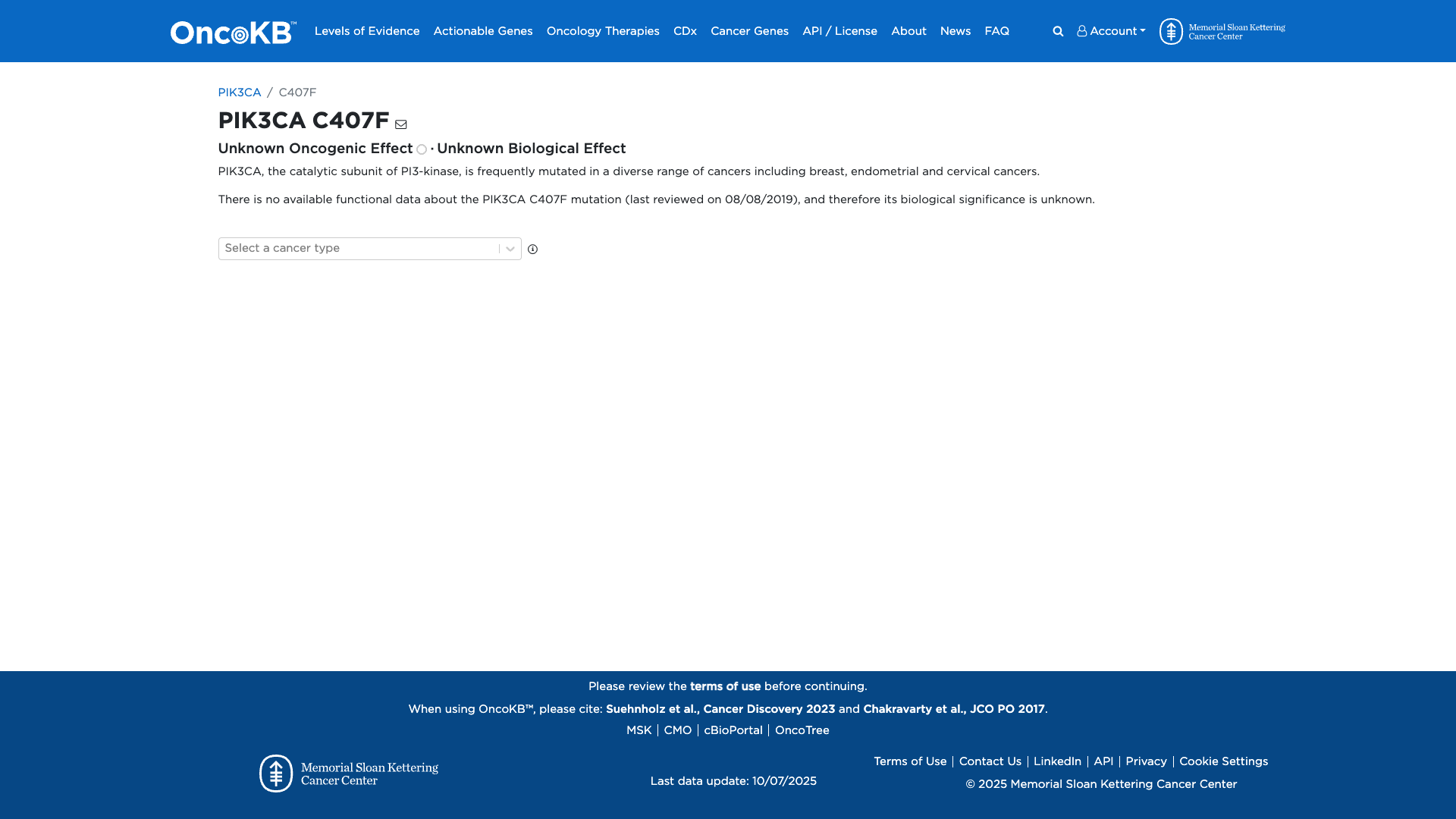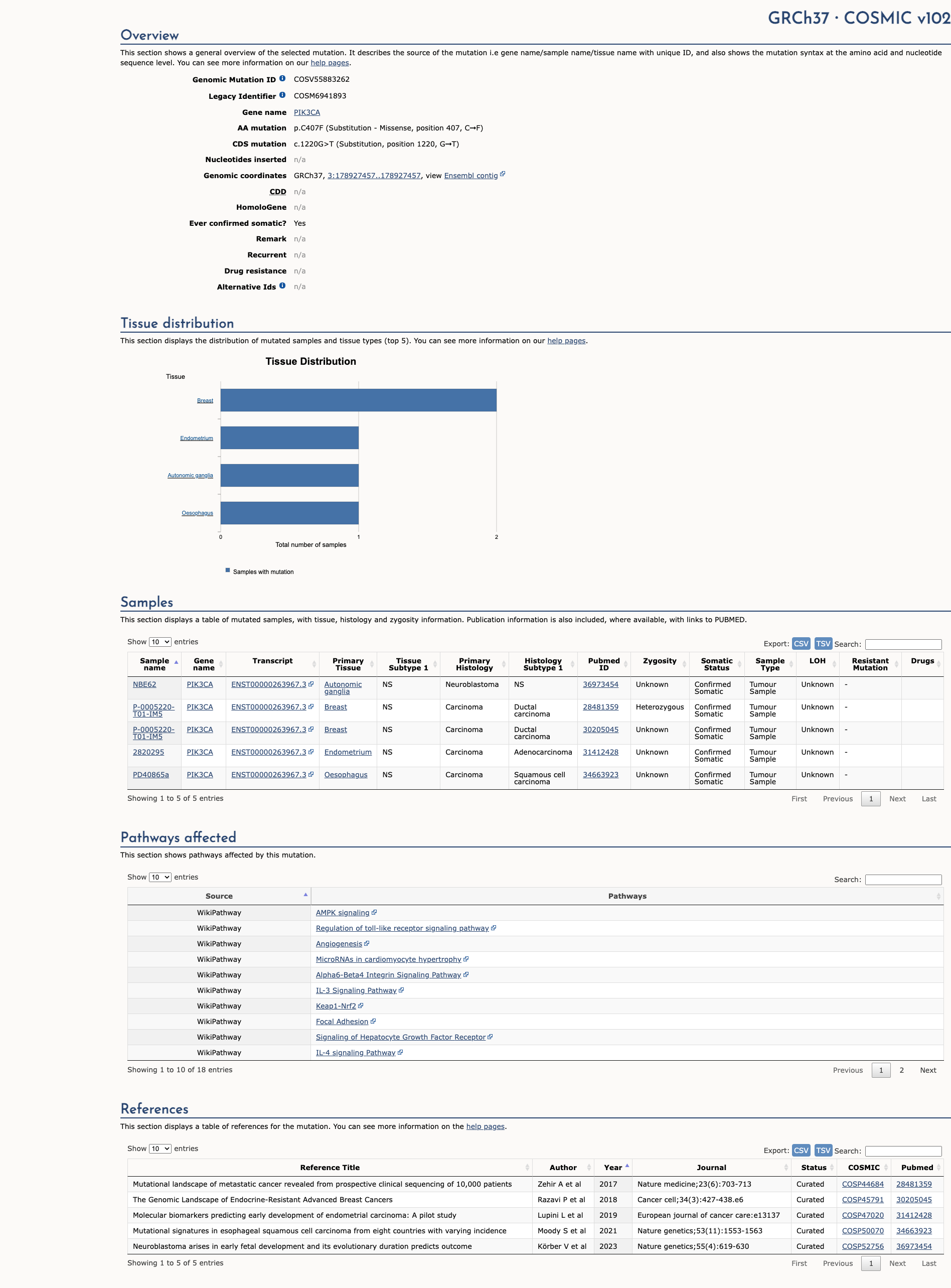PIK3CA c.1220G>T, p.Cys407Phe
NM_006218.4:c.1220G>T
COSMIC ID: COSM6941893
Variant of Uncertain Significance (VUS)
The PIK3CA c.1220G>T (p.C407F) variant is classified as Variant of Uncertain Significance based on two supporting-level criteria (PM2, PP2) and absence of additional evidence to meet thresholds for pathogenic or benign classification.
ACMG/AMP Criteria Applied
PM2
PP2
Genetic Information
Gene & Transcript Details
Gene
PIK3CA
Transcript
NM_006218.4
MANE Select
Total Exons
21
Strand
Forward (+)
Reference Sequence
NC_000003.11
Alternative Transcripts
| ID | Status | Details |
|---|---|---|
| NM_006218.2 | Alternative | 21 exons | Forward |
| NM_006218.3 | Alternative | 21 exons | Forward |
Variant Details
HGVS Notation
NM_006218.4:c.1220G>T
Protein Change
C407F
Location
Exon 7
(Exon 7 of 21)
5'Exon Structure (21 total)3'
Functional Consequence
Loss of Function
Related Variants
No evidence of other pathogenic variants at position 407 in gene PIK3CA
Alternate Identifiers
COSM6941893
Variant interpretation based on transcript NM_006218.4
Genome Browser
Loading genome browser...
HGVS InputNM_006218:c.1220G>T
Active Tracks
ConservationRefSeqClinVargnomAD
Navigation tips: Use mouse to drag and zoom. Click on features for details.
Clinical Data
Population Frequency
Global Frequency
0.0 in 100,000
Extremely Rare
Global: 0.0%
0%
0.05%
0.1%
1%
5%
10%+
ACMG Criteria Applied
PM2
This variant is not present in gnomAD (PM2 criteria applies).
Classification
Unknown
Publications (0)
No publication details.
Clinical Statement
Functional Impact
Functional Domain
Hotspot Status
Not a hotspot
Domain Summary
This variant is not located in a mutational hotspot or critical domain (0 mutations).
Related Variants in This Domain
No evidence of other pathogenic variants at position 407 in gene PIK3CA
Functional Summary
The PIK3CA C407F variant has not been functionally characterized, and its effect on protein function is currently unknown.
Database Previews
OncoKB

JAX-CKB

Click on previews to view full database entries. External databases may require institutional access.
Computational Analysis
Pathogenicity Predictions
REVEL Score
0.558
0.558
Likely Benign0.0
Uncertain (Low)0.2
Uncertain (Med)0.5
Likely Pathogenic0.75
REVEL scores ≥ 0.75 are strong evidence (PP3)
Predictor Consensus
Mixed/VUS
PP3 Applied
No
Additional Predictors
Pathogenic:
polyphen_prediction: probably_damagingprimateai: D
Benign:
CADD: 4.79metasvm: Tmetalr: T
Neutral: Show all
VCEP Guidelines
Applied ACMG/AMP Criteria (VCEP Specific) VCEP Guidelines
PVS1
PVS1 (Not Applied) Strength Modified
According to standard ACMG guidelines, the rule for PVS1 is: 'Null variant (nonsense, frameshift, start codon, splicing +1/2) in a gene where LOF is a known mechanism of disease.' The evidence for this variant shows: it is a missense change (C407F), not a null variant. Therefore, this criterion is not applied.
PS1
PS1 (Not Applied) Strength Modified
According to VCEP guidelines, the rule for PS1 is: '**Strong Strength**: Strong No change.' The evidence for this variant shows: no previously established pathogenic variant results in the same amino acid change at position 407. Therefore, this criterion is not applied.
PS2
PS2 (Not Applied) Strength Modified
According to VCEP guidelines, the rule for PS2 is: 'Strong: Award PS2_Strong if Criteria 1 AND Criteria 2 are fulfilled; Moderate: Award PS2_Moderate if Criteria 1 is fulfilled or if parents are not available but Criteria 2 is fulfilled.' The evidence for this variant shows: no data on de novo occurrence or mosaicism. Therefore, this criterion is not applied.
PS3
PS3 (Not Applied) Strength Modified
According to VCEP guidelines, the rule for PS3 is: 'Strong, Moderate, or Supporting depending on validated functional assay quality metrics.' The evidence for this variant shows: no functional studies have been performed. Therefore, this criterion is not applied.
PS4
PS4 (Not Applied) Strength Modified
According to VCEP guidelines, the rule for PS4 is: 'Points assigned based on phenotypic case data to determine strength; applicable only if variant meets PM2.' The evidence for this variant shows: no reported cases in the literature or patient cohorts. Therefore, this criterion is not applied.
PM1
PM1 (Not Applied) Strength Modified
According to VCEP guidelines, the rule for PM1 is: 'Supporting for residues affecting critical functional domains provided in Table 4 for each gene.' The evidence for this variant shows: position 407 is not within a VCEP-defined hotspot or critical domain for PIK3CA. Therefore, this criterion is not applied.
PM2
PM2 (Supporting) Strength Modified
According to VCEP guidelines, the rule for PM2 is: 'Supporting Absent/rare from controls in an ethnically-matched cohort population sample (≥1).' The evidence for this variant shows: it is absent from gnomAD and other population databases (MAF = 0%). Therefore, this criterion is applied at Supporting strength.
PM3
PM3 (Not Applied) Strength Modified
According to standard ACMG guidelines, the rule for PM3 is: 'Detected in trans with a pathogenic variant for a recessive disorder.' The evidence for this variant shows: PIK3CA disorders are not recessive and no trans observations. Therefore, this criterion is not applied.
PM4
PM4 (Not Applied) Strength Modified
According to standard ACMG guidelines, the rule for PM4 is: 'Protein length changes due to in-frame indels or stop-loss variants.' The evidence for this variant shows: it is a missense substitution without length change. Therefore, this criterion is not applied.
PM5
PM5 (Not Applied) Strength Modified
According to VCEP guidelines, the rule for PM5 is: 'Moderate Strength: No change.' The evidence for this variant shows: no other missense change at codon 407 has been established as pathogenic. Therefore, this criterion is not applied.
PM6
PM6 (Not Applied) Strength Modified
According to standard ACMG guidelines, the rule for PM6 is: 'Assumed de novo without confirmation.' The evidence for this variant shows: no de novo data. Therefore, this criterion is not applied.
PP1
PP1 (Not Applied) Strength Modified
According to standard ACMG guidelines, the rule for PP1 is: 'Co-segregation with disease in multiple affected family members.' The evidence for this variant shows: no segregation data. Therefore, this criterion is not applied.
PP2
PP2 (Supporting)
According to VCEP guidelines, the rule for PP2 is: 'Supporting Strength: Missense constraint computed in ExAC/gnomAD (z-score >3.09) applicable to PIK3CA.' The evidence for this variant shows: PIK3CA is missense-constrained (z-score >3.09) and this is a missense change. Therefore, this criterion is applied at Supporting strength.
PP3
PP3 (Not Applied) Strength Modified
According to standard ACMG guidelines, the rule for PP3 is: 'Multiple lines of computational evidence support a deleterious effect.' The evidence for this variant shows: in silico tools yield mixed predictions with no consensus. Therefore, this criterion is not applied.
PP4
PP4 (Not Applied) Strength Modified
According to standard ACMG guidelines, the rule for PP4 is: 'Patient’s phenotype or family history highly specific for gene.' The evidence for this variant shows: no phenotype data provided. Therefore, this criterion is not applied.
PP5
PP5 (Not Applied) Strength Modified
According to standard ACMG guidelines, the rule for PP5 is: 'Reputable source reports variant as pathogenic.' The evidence for this variant shows: not found in ClinVar or other databases. Therefore, this criterion is not applied.
BA1
BA1 (Not Applied) Strength Modified
According to VCEP guidelines, the rule for BA1 is: 'Stand Alone strength for allele frequency >0.0926%.' The evidence for this variant shows: allele frequency is 0%. Therefore, this criterion is not applied.
BS1
BS1 (Not Applied) Strength Modified
According to VCEP guidelines, the rule for BS1 is: 'Strong strength for allele frequency >0.0185%.' The evidence for this variant shows: allele frequency is 0%. Therefore, this criterion is not applied.
BS2
BS2 (Not Applied) Strength Modified
According to VCEP guidelines, the rule for BS2 is: 'Strong strength if ≥3 homozygotes or heterozygotes in well-phenotyped individuals.' The evidence for this variant shows: no such observations. Therefore, this criterion is not applied.
BS3
BS3 (Not Applied) Strength Modified
According to VCEP guidelines, the rule for BS3 is: 'Strong or Supporting for well-validated functional assays showing no damaging effect.' The evidence for this variant shows: no functional assays performed. Therefore, this criterion is not applied.
BS4
BS4 (Not Applied) Strength Modified
According to standard ACMG guidelines, the rule for BS4 is: 'Lack of segregation in affected members.' The evidence for this variant shows: no segregation data. Therefore, this criterion is not applied.
BP1
BP1 (Not Applied) Strength Modified
According to standard ACMG guidelines, the rule for BP1 is: 'Missense variant in gene where only loss-of-function causes disease.' The evidence for this variant shows: PIK3CA gain-of-function missense variants cause disease. Therefore, this criterion is not applied.
BP2
BP2 (Not Applied) Strength Modified
According to standard ACMG guidelines, the rule for BP2 is: 'Observed in cis or trans with a pathogenic variant in the same gene.' The evidence for this variant shows: no cis/trans observations. Therefore, this criterion is not applied.
BP3
BP3 (Not Applied) Strength Modified
According to standard ACMG guidelines, the rule for BP3 is: 'In-frame indels in repetitive region without known function.' The evidence for this variant shows: it is a missense variant, not an indel. Therefore, this criterion is not applied.
BP4
BP4 (Not Applied) Strength Modified
According to VCEP guidelines, the rule for BP4 is: 'Only for synonymous, intronic, or UTR variants if two of three splicing tools predict no impact.' The evidence for this variant shows: it is a missense change. Therefore, this criterion is not applied.
BP5
BP5 (Not Applied) Strength Modified
According to standard ACMG guidelines, the rule for BP5 is: 'Variant found in a case with an alternate molecular basis for disease.' The evidence for this variant shows: no such data. Therefore, this criterion is not applied.
BP6
BP6 (Not Applied) Strength Modified
According to standard ACMG guidelines, the rule for BP6 is: 'Reputable source reports variant as benign.' The evidence for this variant shows: no such reports. Therefore, this criterion is not applied.
BP7
BP7 (Not Applied) Strength Modified
According to VCEP guidelines, the rule for BP7 is: 'For synonymous, intronic, or UTR variants with non-conserved nucleotide.' The evidence for this variant shows: it is a missense change. Therefore, this criterion is not applied.

